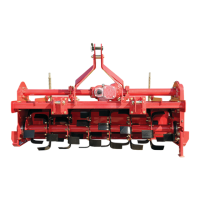30
4.0 MAINTENANCE
The various routine servicing operations required are listed below along with a Maintenance table (which should be
complied with) that briefly illustrates the operations, points and inspection frequencies.
Lower running costs and longer machine life depend on constant and methodical compliance with these
operations.
CAUTION
The given frequencies are indicative and refer to normal conditions of use. They may therefore be subject
to variations in relation to the type of service, a more or less dusty environment, seasonal factors, etc.
In the case of heavy-duty conditions, the maintenance operations should obviously be more frequent.
All operations must be carried out by expert personnel, wearing the proper safety clothing in a clean, not
dusty environment.
All maintenance operations must be strictly carried out with the implement coupled to the tractor, hand
brake engaged, engine off, ignition key removed, and implement lying firmly on the floor.
- Before injecting grease into the lubricators, the greasing points must be thoroughly cleaned to prevent
mud, dust or foreign bodies from mixing with the lubricant, thus reducing or even annulling its
lubricating effect.
- When topping up or changing the lubricant, always ensure that the oil is of the same type as that used
previously.
WARNING
Always keep oils and greases well away from children's reach.
Always thoroughly read the warnings and precautions indicated on the containers. Avoid contact with the
skin.
Always thoroughly and fully wash hands after use.
The utilized oils should be treated in compliance with the current anti-pollution laws.
4.1 FIRST 8 HOURS
SERVICE
- Carefully check the general condition of the machine after the first 8 hours service.
- In particular, you are advised to fully tighten all the screws and bolts on the machine after having checked the
hoe blades for wear.
4.2 EVERY 8 WORK HOURS
- Grease the propeller shaft cross journals.
- Check that the bolts fixing the hoe blades are well tightened.
4.3 EVERY 50 WORK HOURS
- Check the level of the oil in the gearbox or in the reduction unit and top up to the level mark on the rod as
necessary (Fig. 28).
- Transmission latéral par chaine: check the level of the oil in the side casing of the transmission unit, unscrewing
the level/drain plug (Fig. 28) and checking that oil flows out.

